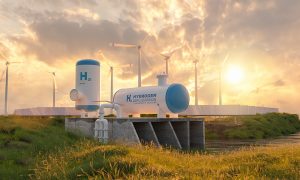Haul marks: On site at Volvo CE’s production plant in Sweden
A visit to Volvo CE’s factory helps explain the strong performance of its machines

Are Volvo Construction Equipment articulated haulers the best in the world? The company itself certainly thinks so. “We are the number one brand in the world,” says Jo?rgen Sjo?, manager of the factory in Braås, Sweden, where the company’s full range of artic haulers are manufactured, including those shipped to the Middle East.
History is on Volvo’s side. The forebear to the modern articulated dump truck (ADT) was invented in Braås by LIVAB, who used an agricultural Volvo tractor towing an articulated single-axle body, with the tractor’s power take-off (PTO) used to drive the tipper. Developments which quickly followed included an adapted model which dropped off the tractor’s front axle, giving the distinctive ‘nose’ of the ADT which remains today.
BM-Volvo produced its first hauler with all-wheel drive in 1966 (see below) and has consistently rolled out new generations of models, including in 2007 celebrating 40 years and 50,000 models. Today, its range consists of three models: the 30t payload A30, the 35t payload A35 and the largest of the three, the A40, which can carry 40t. In the Middle East and other non-regulated markets, these are F-series, while in the US and Europe and other stringent emission markets it sells the G-series. The only difference between the two series is engine after-treatment to comply with regulations.
A tour of the Braås factory gives an insight into why Volvo is so bullish about the quality of its dump trucks. The 45,000sqm factory is notable in that the full production process takes place within its confines, though of course with major components such as engines and transmissions sourced from nearby Volvo factories. Steel plates arrive at the beginning of the process, and are cut by lasers according to the design plans. Use of laser cutting achieves a number of objectives, including high accuracy and fewer off-cuts, and also creates notches and grooves which ensure the plates fit together snugly when welded, and pre-cutting of holes for components to slot into, avoiding the need for drilling and other work further down the production line.
The haulers use high-strength 400 Hardox steel for the bodies of the hauler, supplied by local steel major SSAB. 450 Hardox wear plates are also available as an option, for applications such as hauling Norwegian granite, which is highly abrasive. The frame uses ordinary steel, since flexibility rather than rigid strength is needed.
Perhaps the most important piece of steel on the machine is the hitch, which is supplied fully cast direct from foundries in the UK and France, a solution that ensures maximum robustness, with only minor machining in the factory.
Once cut, human workers carry out tack wielding on the steel plates to hold them in position. The plates are then moved into bays, where the remainder – and majority – of welding is carried out by robots. Inspecting the weld seams makes clear the advantage of using robotic welding over manual work, with the long seams along the payload body – which is formed by four major pieces of the Hardox steel – virtually flawless. Human welders can’t consistently manage this level of quality. Follow-up welds in the corners and other hard-to-reach places where the robots can’t work are done by hand.
Once assembled, shot-blasting is next. The Braås factory uses stainless steel shot rather than sand, since it is more effective in preparing the surface in order to make the paint adhere and can also be removed using a magnet, unlike sand.
Painting takes place in the huge chambers, with the parts emerging covered in an epoxy paint that is almost always Volvo’s distinctive yellow, barring occasional special requests. Once painted, the frames move over to the assembly line where the drive line is installed, from the Volvo transmission and engines (the engine is based on a Volvo Trucks engine rather than a construction machine) to the cabin and guard-rails, before finally the tyres. Afterwards, each truck is taken on a test run on the adjacent proving ground for more than an hour, with full testing of all quality aspects. Any defects from the production process detected, or any scratches in the paint, can be rectified in the so-called ‘emergency ward’.
The whole process takes nine days for a single machine, but eight machines can be produced per day, or forty per week while the factory is running at single shift. Sjö wouldn’t disclose annual production volumes, citing commercial sensitivity, but operating at single shift the factory can produce around 2,000 machines per year. During the boom of 2007-2008 it was operating at double shift and producing a much higher volume, but the appetite for ADTs is quite volatile and sensitive to any downturn in the economy, explains Sjö, since larger projects are typical buyers of the product. It’s also seasonal, with greater demand in the European spring, when major projects commence earthworks.
Volvo’s ADT has proved its worth in the Middle East on a number of projects, notably the Empty Quarter road project carried out by Al Rosan in Saudi Arabia, where 68 were used to haul sand. The machine is ready to work in the region without any special modifications, though it is often equipped with air filters – either cyclonic or an oil bath – to remove dust and sand from the air intake. Cabins can also be fitted with asbestos filters.
Tyres are a major cost component across a truck’s life, and Volvo CE haulers can be optioned with a number of tyre brands. For driving on sand, flotation is most important, says Sjö, rather than traction, which causes tyres to dig in. Haulers can’t avail themselves of the tyre pressure control systems found on military-style vehicles, which can lower the pressure automatically while driving on sand, since their payload is constantly varying.
With the haulers having a long reputation for toughness, it’s no surprise that they’re a popular choice for contractors and quarries alike.
Gravel Charlie
The roots of the articulated hauler go back to agricultural trailers, with the addition of a trailer with its own drive wheels patented in 1946 by Swedish firm LIVAB in Braås. The company also cooperated with Bolinder-Munktell in Eskilstuna, then a subsidiary of AB Volvo.
Once the patent expired in 1963, competition intensified. One of the key innovations was to remove the front axle of the agricultural tractor, giving artic haulers the distinctive pinched nose which still exists today.
Introduced in 1966, the BM-Volvo DR 631, better known as Gravel Charlie, was the world’s first series-manufactured articulated hauler, and a new technical concept for its time. Features included articulated steering, large wheels, all-wheel drive and differential locks.
Launched only the next year, the BM-Volvo DR 860 was a revolutionary hauler that laid the foundations for many of the features taken for granted on the modern machines. This included an oscillating and steered articulated hitch, a bogie design to even out irregularities in rough terrain, low ground pressure due to large tyres with low inflation, and two- or four-wheel drive. Used predominantly for road construction and gravel and earth haulage, the DR 860 and its subsequent iterations (the 860 series) were manufactured from 1968-86, with a total of 17,160 units produced.
Source: The Munktell Museum
A carbon-neutral factory
The hauler factory in Braås has the distinction of being the first factory in the construction machinery industry which can claim to be carbon-neutral. In large part, this has been achieved through certification via its local utilities company that all its electricity is obtained from renewable sources – including wind, biomass and hydropower – that neither produce harmful emissions nor contribute to the greenhouse effect.
Announced early last year, this followed in the footsteps of sister company Volvo Trucks, whose Ghent facility set the standard for emissions-free industrial manufacturing in 2007.
Braås’ first step towards carbon neutrality began in 1999, when it commissioned local energy supplier Växjö Energi AB to install a district heating plant, fuelled by wood chips, to provide central heating for its employees and the town’s residents. Braås then joined a Volvo Group initiative in 2007 that saw it switch to green electricity (i.e. generated from renewable sources).
These first two initiatives brought the site’s level of CO2 neutrality to 87% in 2008, with the final push to reach 100% beginning in 2012. Staff identified the greatest source of energy consumption as the liquefied petroleum gas (LPG) burners used to heat the rust protection treatment ovens to 60°C. These were systematically replaced with district heating from September 2013. The burners in the component paint shop, which reach temperatures of 120°C, were also altered to electrical heating. In addition, the site’s diesel forklifts were substituted with electric battery models.

























